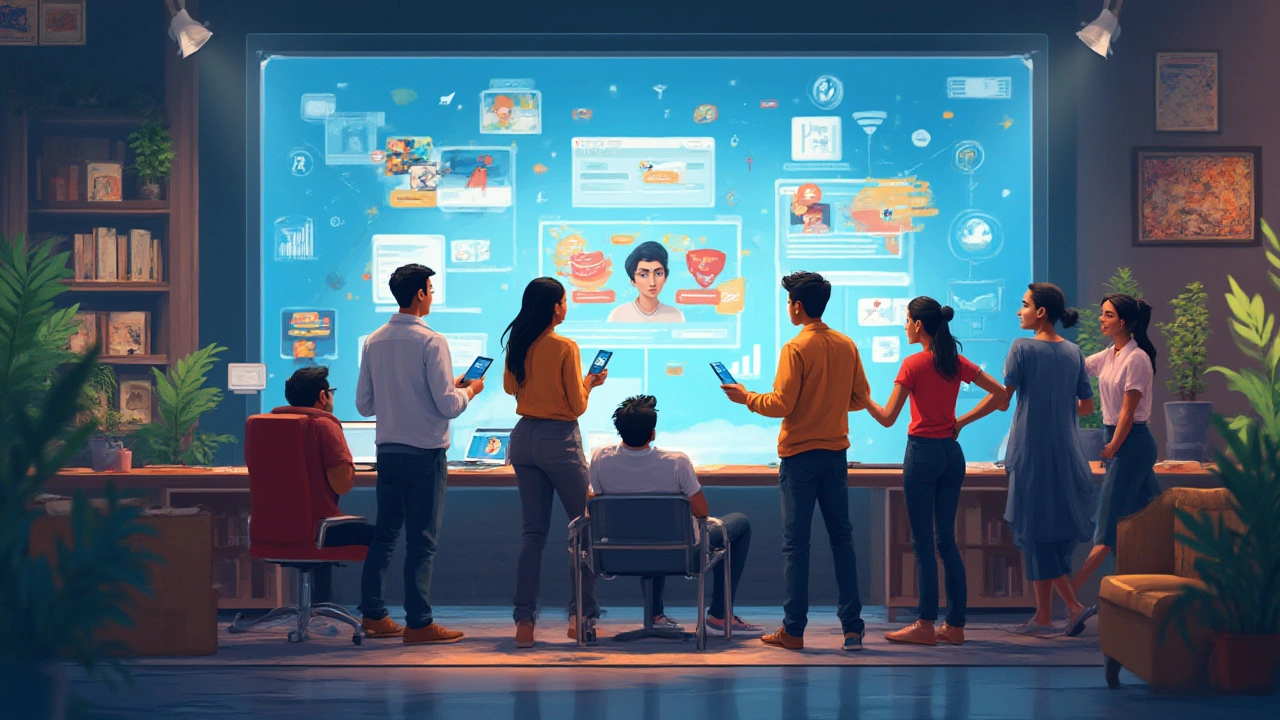Imagine trying to get through your workday without checking your email, scrolling through socials, or hopping onto Zoom for a meeting. Feels weird, right? That’s because digital platforms are our silent sidekicks, running almost every corner of our lives. People have apps for dating, shopping, managing their money, and even training their dogs. Yet, most folks don’t stop to think about what makes these platforms tick or why they’re so effective.
What is a Common Digital Platform?
The term “digital platform” gets thrown around a lot, but at its heart, it’s a piece of tech that connects people or services online. Think of a platform as a digital stage where users and providers show up and interact. Want a real example? Facebook, Google Drive, and Amazon are all digital platforms, but each does something different. Facebook brings people together to connect and share. Google Drive lets you create, upload, and collaborate on files with friends or colleagues. Amazon connects millions of sellers with buyers all over the world. Pretty cool, right?
Most common digital platforms fall into a few main buckets: social media, e-commerce, cloud storage, communication, and productivity. Each category covers a range of tools you probably know and use. This mix gives us everything from instant messages and face filters to project management dashboards and video calls. The magic is in the connection. Platforms don’t just provide tools—they link people, ideas, and solutions. Social media has 4.95 billion users as of August 2024, according to DataReportal, showing just how much we rely on these spaces for daily life. If a platform can pull in that many users, it’s doing something right.
One tidbit most people overlook: a single platform can wear a lot of hats. Take Microsoft Teams, for example. It’s where coworkers chat, jump on calls, share files, and plan stuff together. It combines different digital needs in one place. The best ones are so easy to use you barely notice them weaving into your routine until you try to spend a day offline.
Here’s a quick table to show how digital platforms slot into daily life:
| Type | Popular Example | What It Connects | Active Users (2024) |
|---|---|---|---|
| Social Media | Individuals, influencers, brands | 2.4 billion | |
| Cloud Storage | Google Drive | Files, teams, devices | 1 billion |
| E-commerce | Amazon | Buyers, sellers | 310 million |
| Productivity | Trello | Projects, teams | 50 million |
| Communication | Messages, calls | 2.8 billion |
So when someone asks, "What is a common digital platform?" – the answer is simple: it’s any online service that helps connect people, stuff, or ideas as part of your everyday routines, often without you even noticing.
Why Are Digital Platforms So Influential?
These days, digital platforms have more power than ever. The biggest reason? They sit at the very center of our personal and work lives. Every time you check a review before ordering lunch or attend a virtual yoga class, you’re tapping into a platform. What’s wild is how platforms shape our behavior. For example, 87% of shoppers now read online reviews before buying anything, according to an August 2024 BrightLocal study. That means a single digital platform can steer the fate of any business with a five-star (or one-star) rating.
Platforms have also wiped out boring, repetitive tasks. Try picturing life before cloud storage. Colleagues emailed files back and forth, tracked edits by hand, and crossed fingers nobody overwrote the good copy. Now, platforms like Google Drive or Dropbox let whole teams see changes in real time. No more duplicates, lost attachments, or messy folders. That’s more time to actually get things done.
Even the way we find jobs is all about platforms now. LinkedIn has transformed hiring. Instead of paper resumes and long agency waits, most recruiters today use AI-powered searches to sift through profiles and “match” talent to open roles. A report by Statista in June 2024 found that over 80% of recruiters use LinkedIn for candidate searches. Gone are the days when opportunity was about knowing a guy — now, digital visibility is everything.
But it’s not just about efficiency. Digital platforms make it possible to scale up and reach the world. Tiny indie businesses hit global markets thanks to Etsy or Shopify. Artists and writers build fan-bases with platforms like Patreon or Substack. Even garage bands can hit the big time using streaming services and TikTok. One viral post, one catchy video, and suddenly millions are watching. That kind of reach was a pipe dream 20 years ago.
Of course, no platform is perfect. When your favorite service crashes or goes dark, it’s a jarring reminder of how much we depend on software to keep things running. Regular users often feel powerless when algorithms change or privacy terms shift. Still, most of us keep logging in day after day, because these digital spaces just make life easier.

The Most Popular Digital Platforms of 2025
So what’s hot right now? A few platforms have managed to keep ahead of the curve by constantly evolving with user needs. TikTok, for instance, raced past 1.7 billion active users by 2025. It doesn’t just entertain—it influences trends, election cycles, and even where people shop. All that from a steady stream of short videos and some serious AI magic.
Microsoft Teams and Slack are now the default for work chats and meetings. As of early 2025, Microsoft Teams had 350 million daily active users, a number that’s double what it was three years ago. They integrated video calls, shared whiteboards, and even apps for polls or project workflows. Platforms that juggle it all under one roof tend to pull ahead.
Shopping? Amazon’s still epic, but don’t ignore Shopify’s rise. In June 2025, Shopify said they had over 2 million merchants worldwide, many being tiny stores or first-time entrepreneurs. Shopify’s secret: easy setup, loads of payment options, and a boatload of third-party plug-ins. That’s a big reason anyone can launch a store in an afternoon (and some do!).
Social platforms are evolving too. Instagram remains a top player with its blend of photos, Stories, and now, seamless in-app shopping. Users can discover a new brand and buy its latest drop without ever leaving the app. Meta, the company behind Facebook and Instagram, keeps rolling out fresh features to stay sticky – like more AI filters, interactive polls, or short collab videos. Even with competition, these platforms adapt fast to stay part of daily habits.
Education’s also gone platform-heavy since the pandemic. Platforms like Coursera, Khan Academy, and Duolingo have grown rapidly because they blend interactive lessons, adaptive tech, and worldwide access. In 2024, Coursera reported over 124 million registered users—a tenfold jump from a decade ago. So whether you’re learning Spanish or how to code, there’s probably a platform with a crowd of students just like you logging in every morning.
Tips for Choosing and Using a Digital Platform
There are so many platforms out there that picking the right one can feel like navigating a maze. Here are some real-world tips for making the process less of a headache:
- Know what you need: Before downloading the latest “hot” app, ask yourself what problems you’re trying to solve. Productivity apps won’t boost your creativity if all you want is a mood board app like Pinterest.
- Check user reviews and ratings. Pay close attention to comments about bugs, support, or sneaky fees. Real users often tell you what promo sites won’t.
- Test drive with free versions first. Many platforms offer a basic tier so you can try before you buy. That way, you’re not locked in if it doesn’t fit you or your team.
- Look for integration and compatibility. If you already use Gmail, check if your short-list of platforms offers easy tie-ins or plug-ins so you don’t waste time on manual workarounds.
- Keep your data safe. Read privacy policies (or at least skim them) and use strong passwords. Cybersecurity threats are real, and platforms are prime targets.
- Don’t chase every trend. Just because a platform is popular doesn’t mean it suits your workflow. Focus on the features that make your life easier or save you time. Quality beats hype every time.
- Stay up to date with updates. Developers often add cool features or fix security holes based on user feedback—but only if you install the latest version.
- Consolidate when you can. Using too many platforms at once can slow you down. If there’s a tool that covers lots of needs under one login, it can cut down on confusion.
- Watch for hidden costs. Free trials and microtransactions can add up fast. Make a habit of checking your subscriptions and auto-renew dates so you don’t get unexpected charges.
- Make sure real people use it. Check active user stats or recent reviews—an abandoned or outdated platform can leave you in the lurch when you least expect it.
Remember, the perfect digital platform is the one that fits your workflow and makes daily tasks smoother. It isn’t about using the latest trend, but finding a tool that works for your unique needs.

The Future of Digital Platforms: What’s Next?
Now, here’s where things get interesting. Platforms aren’t slowing down—if anything, they’re getting smarter. AI is now running the show behind the scenes, personalizing feeds, monitoring security, and powering the next big user experiences. As of July 2025, about 60% of major platforms (like Spotify, Meta, and Google) use AI to filter content and recommend what you might like next. That’s not just a nice-to-have. It’s a game-changer for user retention.
Voice and gesture controls are also making waves. With smart speakers and VR headsets moving mainstream, some platforms are ditching keyboards altogether. People can now talk, wave, or move to control what happens on their screens. It’s now faster to say, “Play my gym playlist,” than to type and scroll. Apple’s Vision Pro, released in 2024, is rewriting how users interact with digital content using gestures and eye-tracking tech.
Privacy, though, sits top of mind for everyone. High-profile data leaks, like the 2025 “FinFlow” breach, have made users more watchful about where their info goes. In response, platforms are rolling out new encryption features, optional anonymity modes, and clearer user controls. Expect a lot more focus on security and privacy settings as platforms fight to gain user trust.
What about work? Digital platform workspaces are pushing the remote and hybrid trend further. There’s less “clocking in” at an office, more collaborating from anywhere—be it a beach café or at home in pajamas. This shift is changing not only how teams collaborate, but where people decide to live and how companies hire new talent.
Some platforms are even dabbling in digital currencies and blockchains to cut out middlemen and move money instantly between users worldwide. It’s not just for crypto traders. Gaming platforms, ticket sellers, and artists use blockchain to protect their work and get paid faster. This financial angle might totally change how creators and consumers interact in the next few years.
So, what is a common digital platform in 2025? It’s so woven into daily routines that most folks hardly give it a second thought until it’s unavailable. It helps us work smarter, stay connected, and juggle life’s demands with a tap or swipe. If you’ve ever wondered how the modern world keeps moving at this pace, thank those silent digital stagehands running in the background. There’s a whole world of options out there—pick one that fits your daily rhythm, and see just how much smoother life can get.





Write a comment